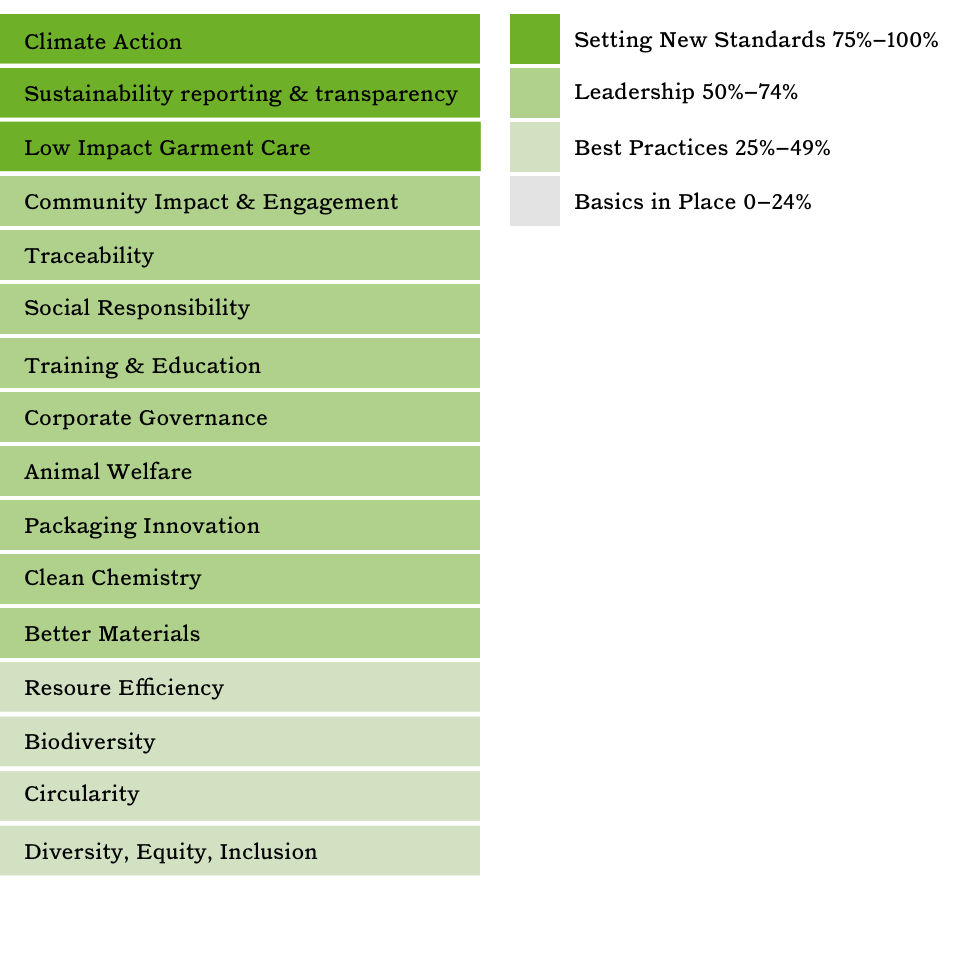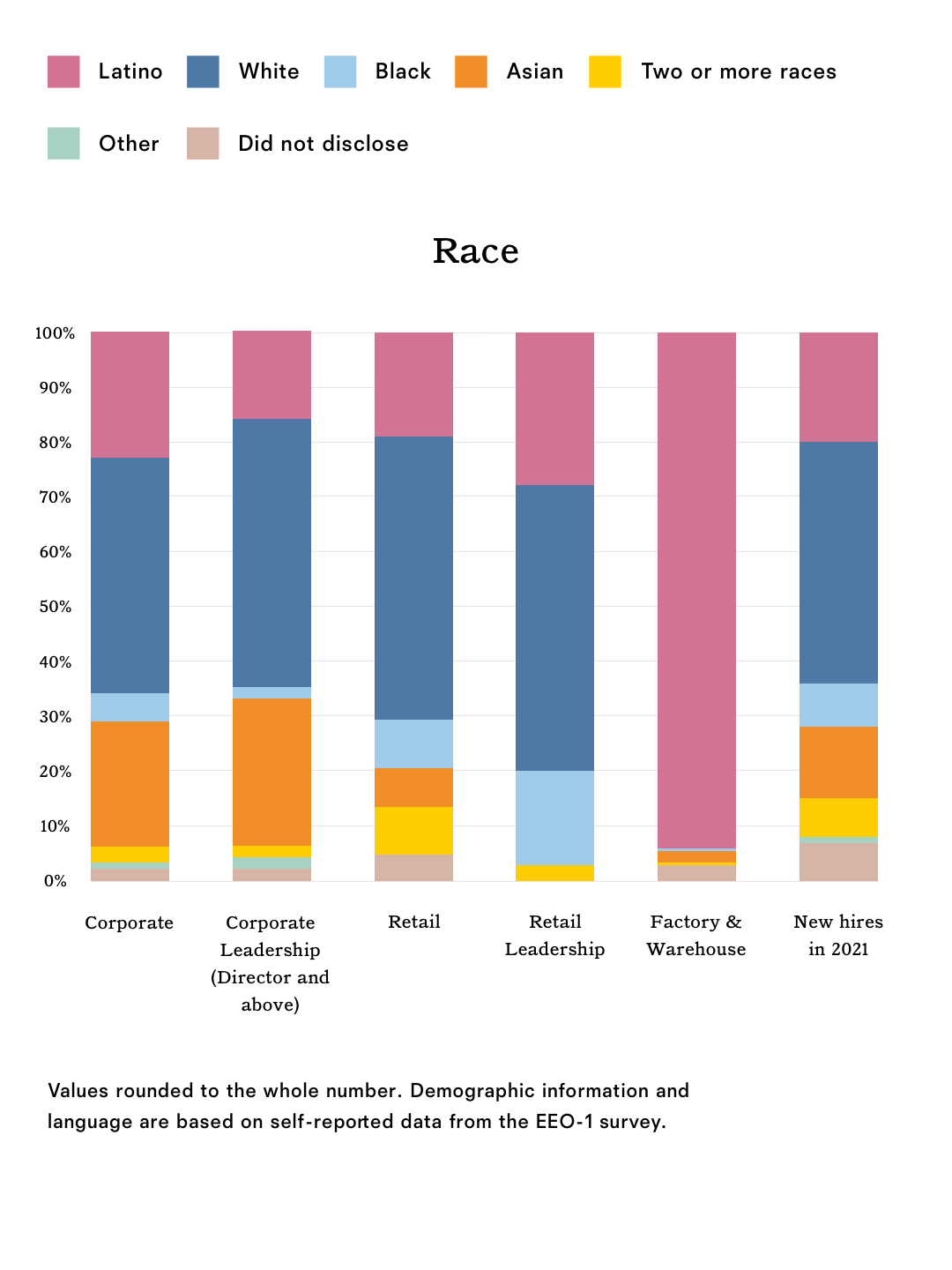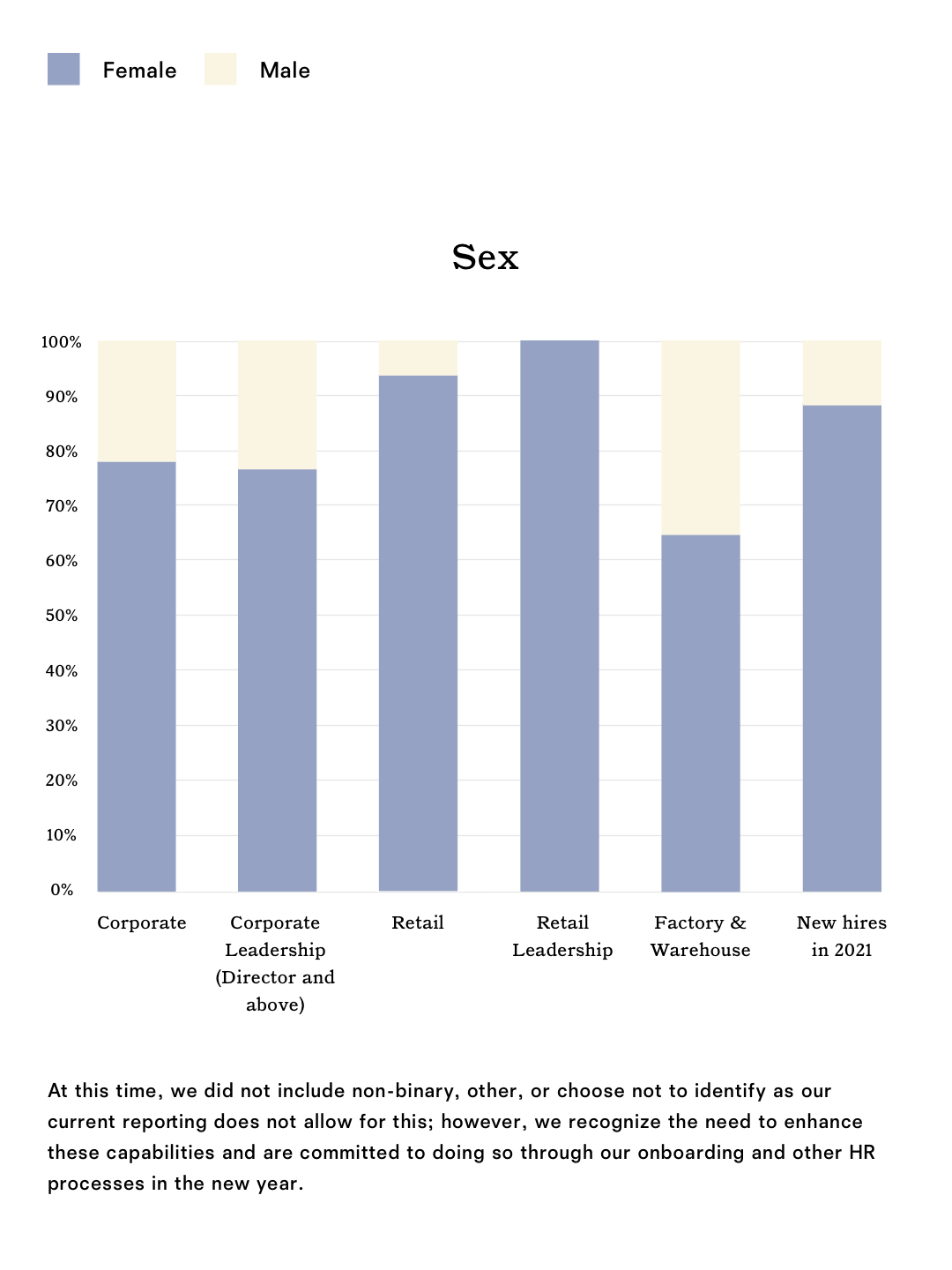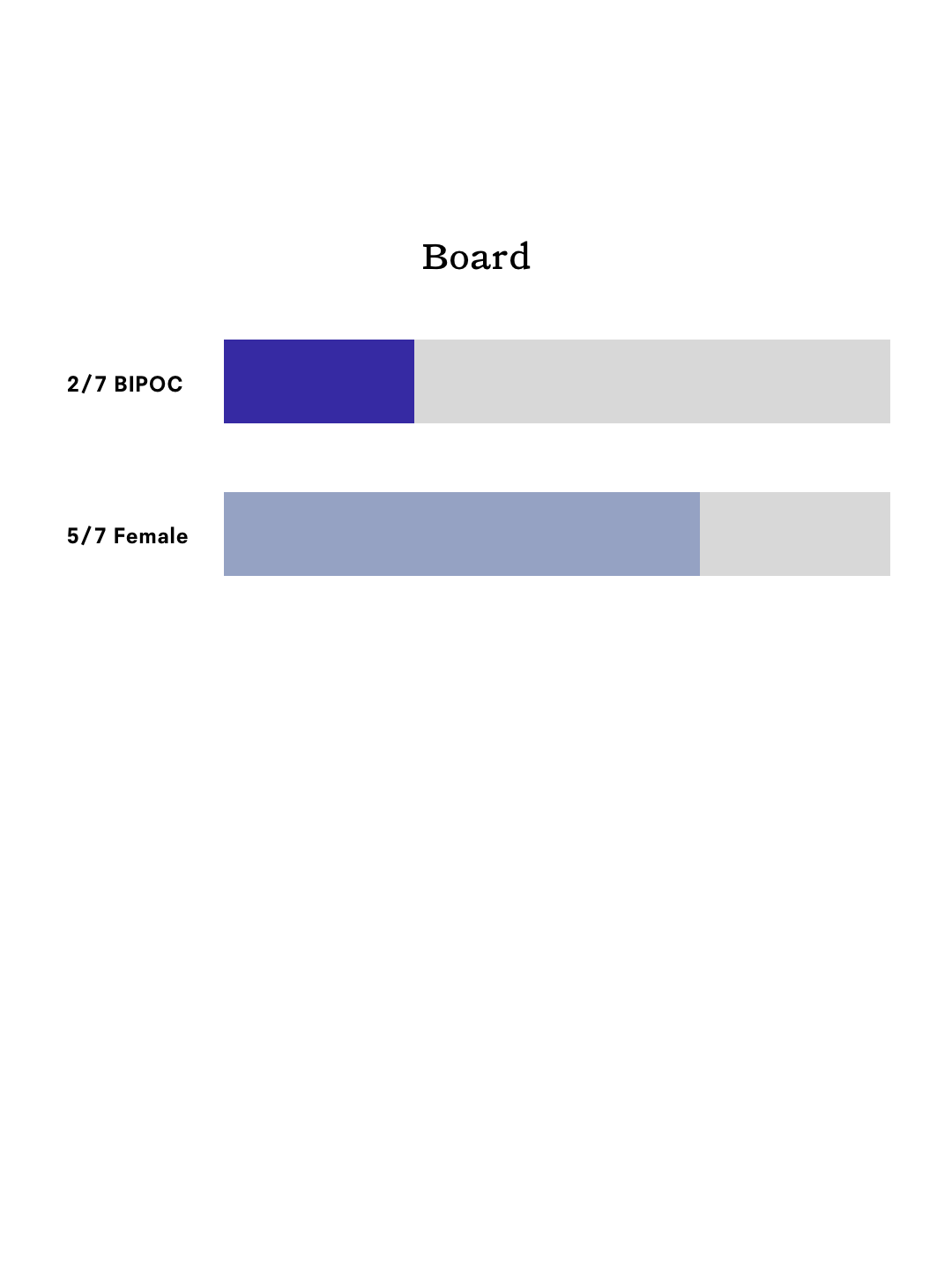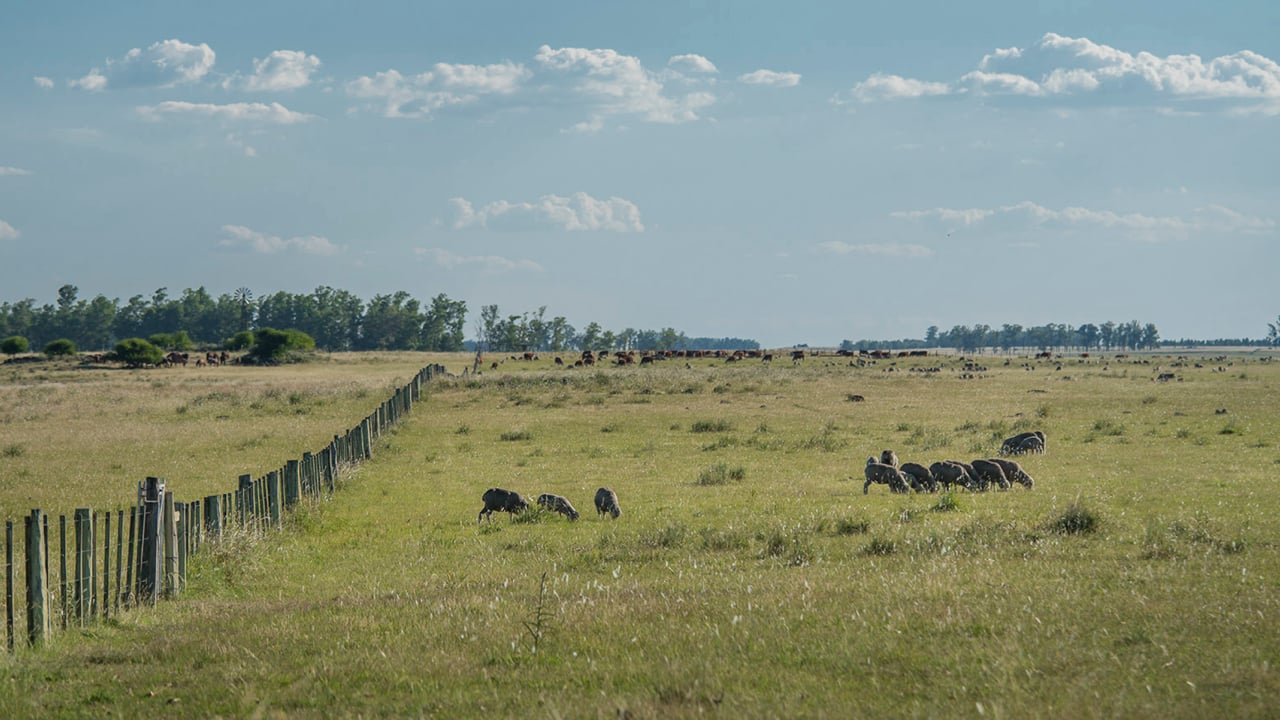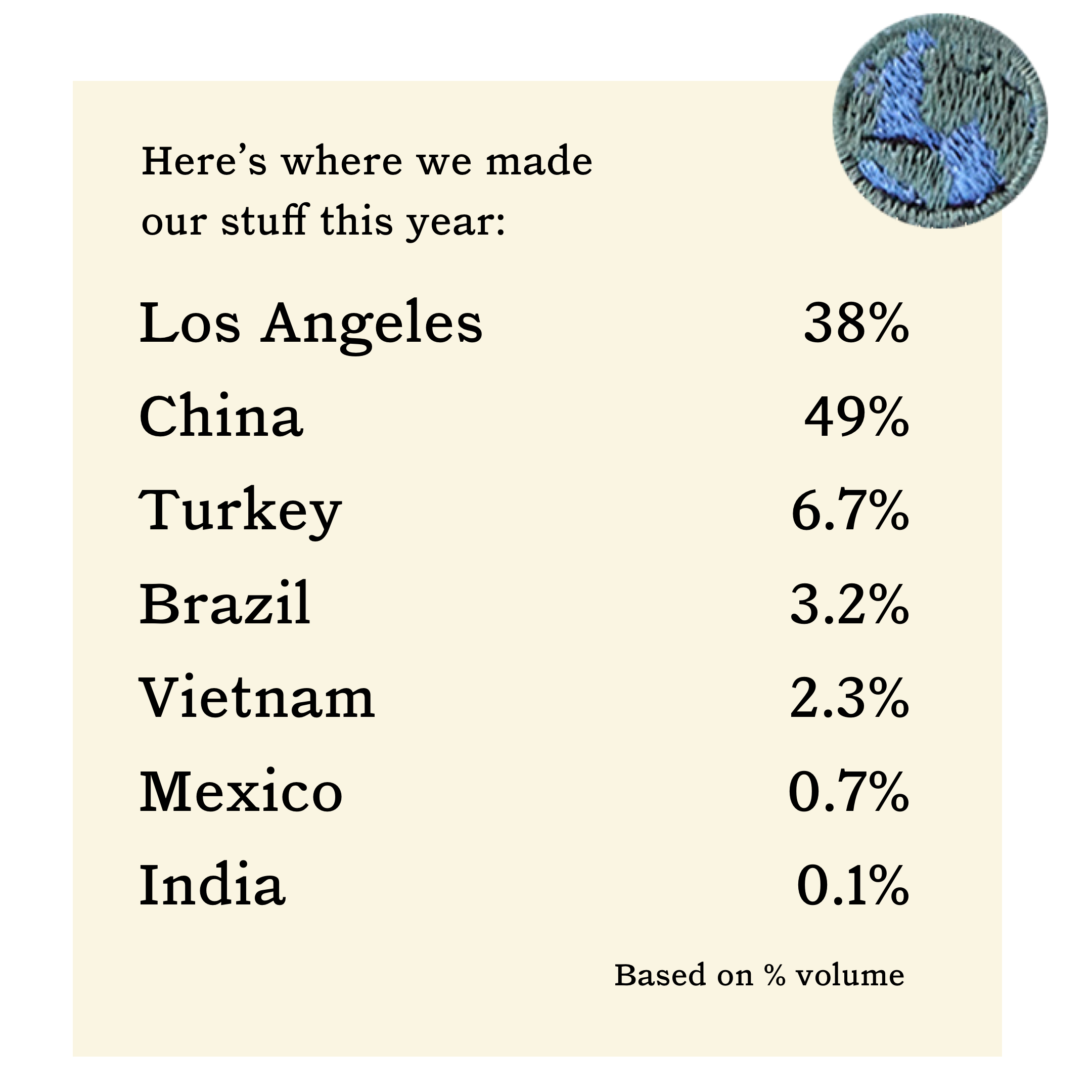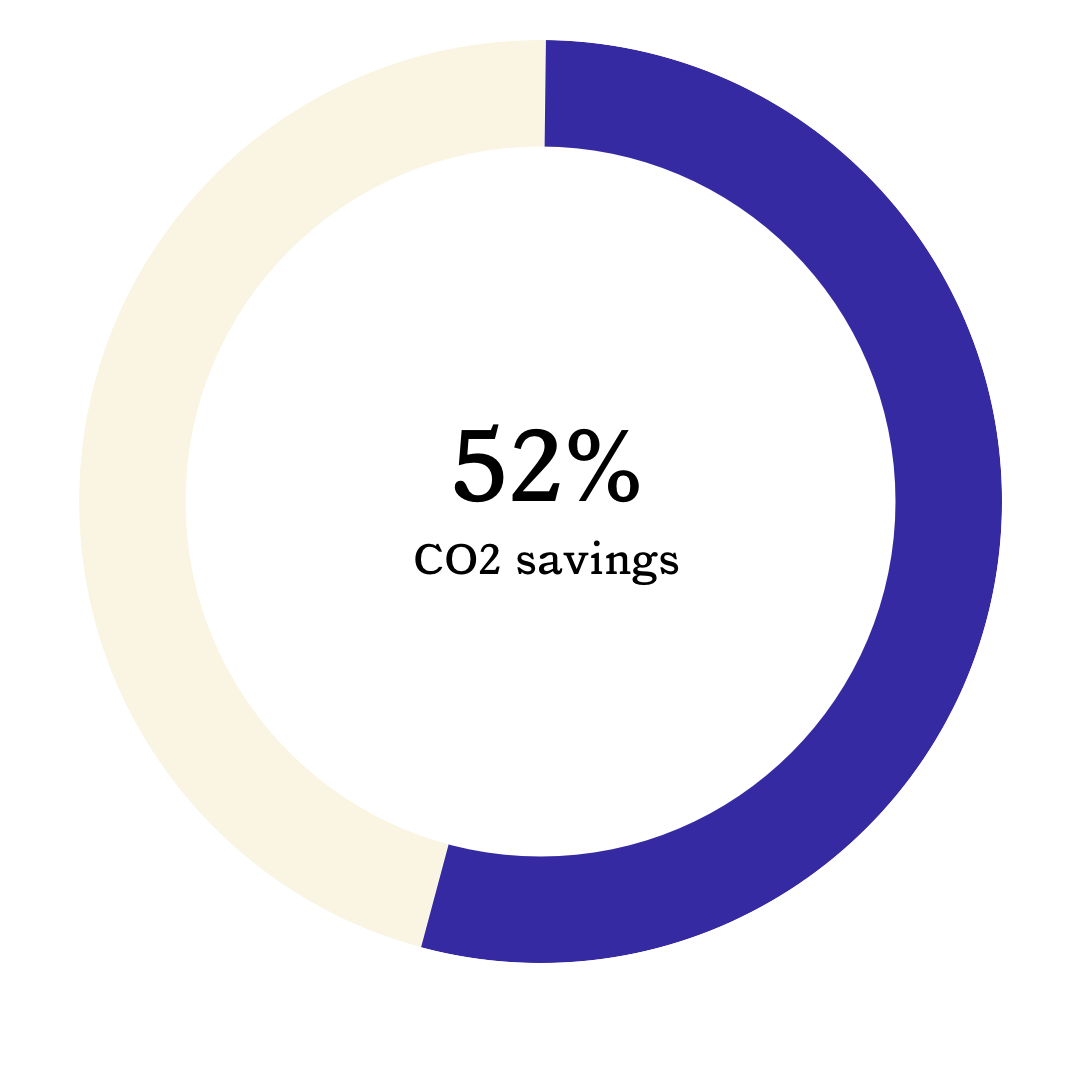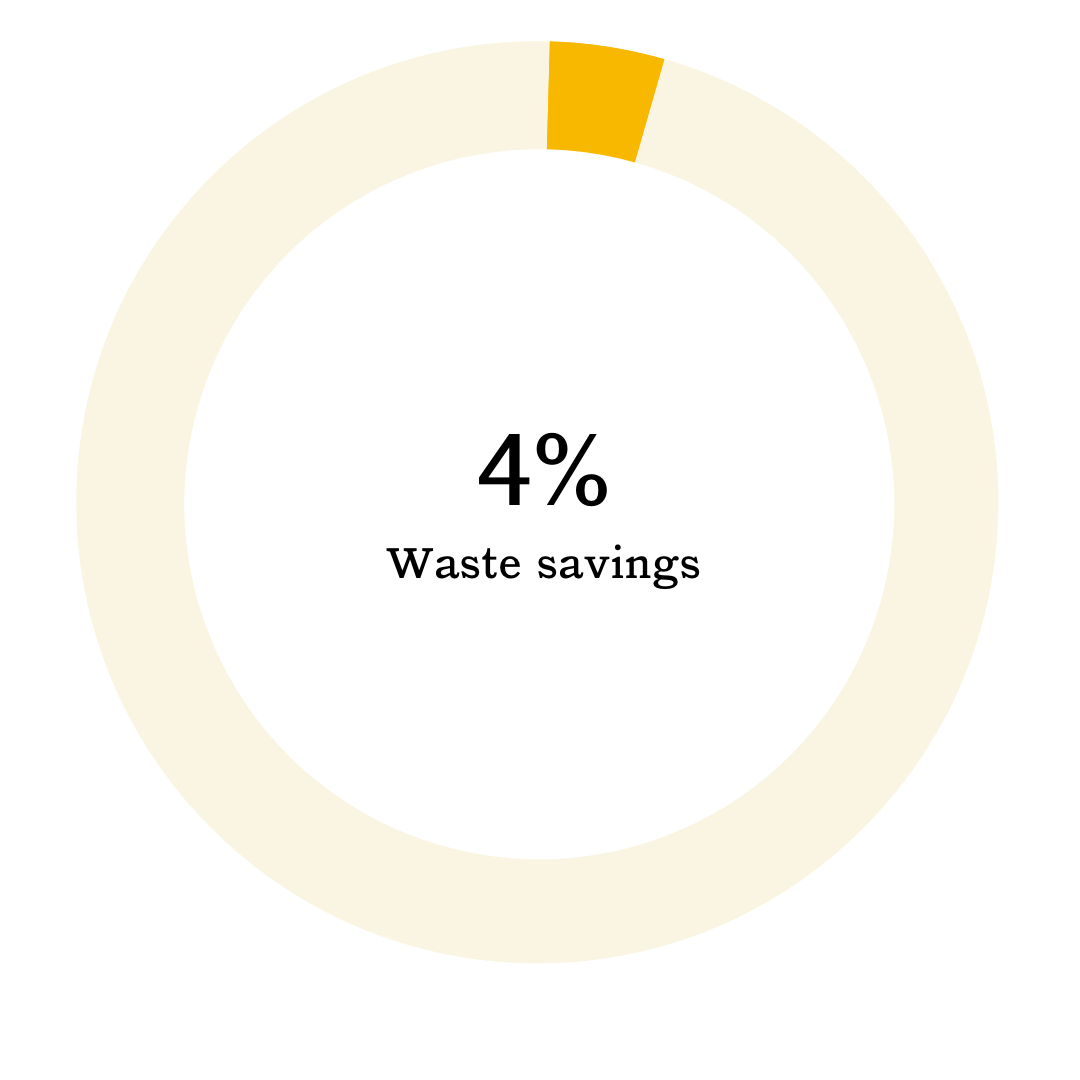Sustainability Report Q4 2021
THE SUSTAINBILITY REPORT:
2021 YEAR IN REVIEW
THE SUSTAINABILITY REPORT: 2021 YEAR
IN REVIEW
Okay, so we know 2021 felt more like 2020 than most of us expected. But if there is one bright spot, it’s that climate change is finally being taken seriously by more big companies. Sustainability has been our priority since we were founded in 2009, so this report isn’t just about last year, really. It's about what we did in 2021 to make progress towards our long-term commitments.
Our mission to bring sustainable fashion to everyone continues to be an important guide to shape our strategy–how we prioritize investments and how we make decisions. We use these reports to be transparent about what we’re doing and why. We celebrate our wins. And talk about where we fall short. We’re approaching 2022 with a greater sense of urgency, more means for accountability (including from people like you asking more of brands), and more investment and collaboration for us all to do this work in 2022. Let’s do it.

Sustainability scorecard
We want to be the best we can be so we asked Eco-Age, a third-party sustainability strategy agency, to measure our progress and help us find opportunities to grow as leaders in sustainable fashion. Each year, Eco-Age makes changes to the benchmark to reflect the ever-changing sustainability landscape. In 2021, they added five new topics (including Biodiversity, Circularity, and Animal Welfare) and made this the most rigorous assessment yet.
HOW WE STACKED UP
Eco-Age measured our performance across sixteen different topics, aligned with other industry reporting frameworks and priorities.
We’re excited that we earned a Leadership rating for our overall score for the second year in a row, and have at least Best Practices for all topics.
You can read the full report here to dig into the details and recommendations and check out the scorecard methodology here.
The results and recommendations are an important input into the work we plan to do. Get a detailed look at our proposed plans in our updated Sustainability Framework.
Eco-Age helps us review our work as a whole, but keep reading for our 2021 highs and lows and an in-depth look at where we're headed in our four main areas: People, Product, Planet, and Progress.
PEOPLE
There are a lot of awesome people behind our clothes, and we are responsible for ensuring safe, healthy, and equitable working conditions for every single one of them.
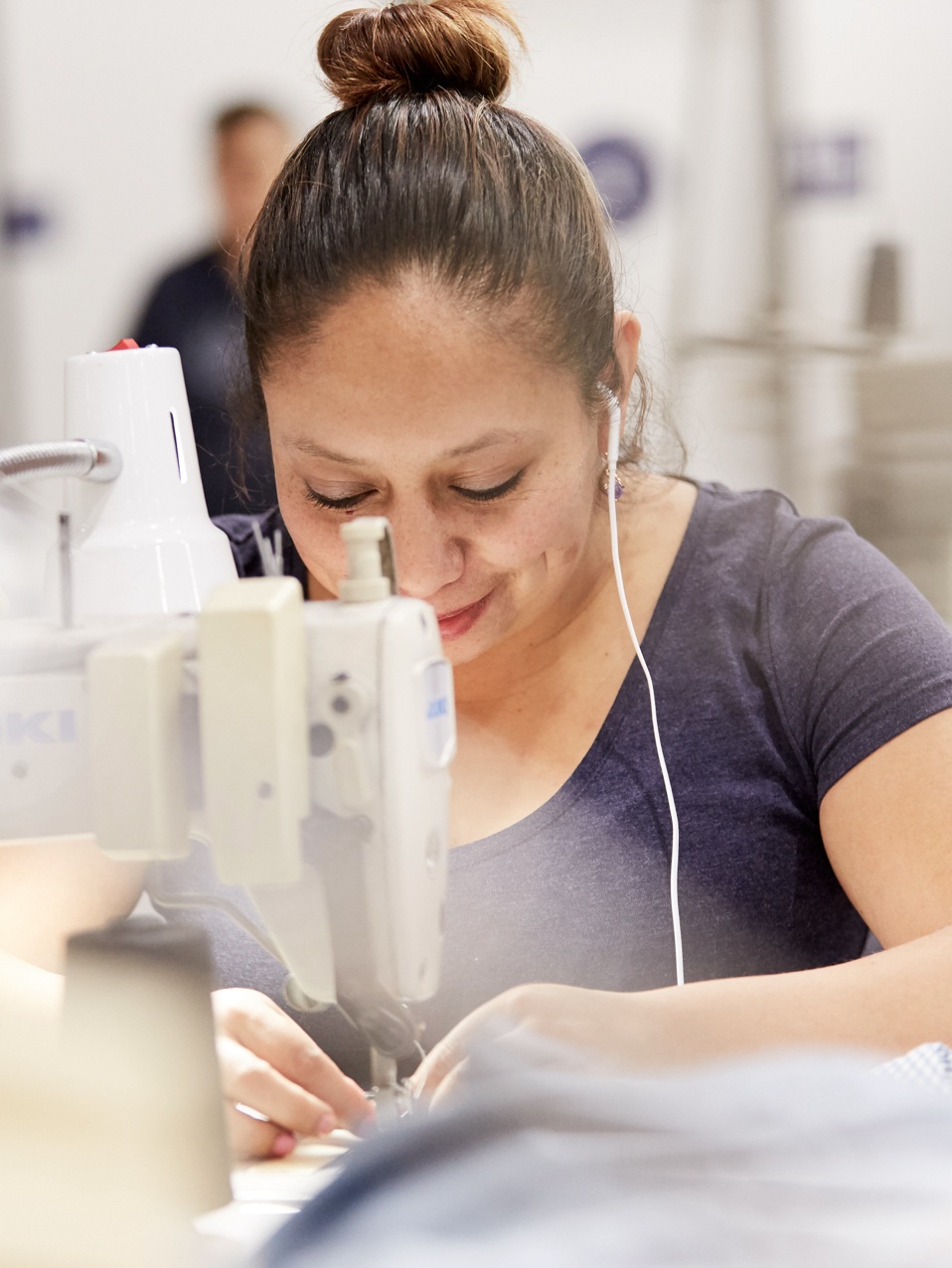
2021
HIGH
Joined the Fair Labor Association
We joined the Fair Labor Association (FLA) in 2021 as an Affiliate Participating Company to improve working conditions throughout our supply chain. We’re committed to expanding programs to support workers and protect their rights with the support and collaboration of the FLA and its members.
LOW
Moving target for living wage
The US living wage increased approximately 20% in 2021 due to updated methodologies and data sources. So we went from 100% to 59%1 compliant with the current living wage standard for our employees. We believe all workers should have the ability to meet their basic needs and maintain self-sufficiency. We processed significant wage increases in 2021 and will continue this work in 2022 and beyond. It won’t happen overnight, but we’re committed to pursuing fair wages for all Reformation team members.
2022
FOCUS
Education for action
We believe that positive change happens through communication, collaboration, and education. So we’re building a new and engaging sustainability platform that educates our employees, customers, and partners and connects them to real solutions and ways we can all take action.
Our commitment to DEI
We’re committed to making Ref both a great place to work and a brand that reflects and respects the diversity of our world. At Ref, we are working to improve representation at all levels of the company and increase our team’s sense of belonging and engagement each year. We know that as a company and member of the global community our work will never be done here. But it is important that we remember that this is not an objective that we solve overnight–it is a way of thinking, working, and interacting that is deeply rooted in the understanding that DEI is ongoing work.
We believe an important place to start is to adopt equal hiring practices and tools. Starting early this year, we’re partnering with Mathison, a platform for diversity hiring and retention. Mathison has a lot to offer our teams in terms of learning, best practice development, and practical recruiting support to make sure we’re reaching a more diverse workforce.
Here’s our 2021 end of year snapshot of team demographics. Given improvements in how we collect this information and develop reports, we’ll use this as our baseline to track future progress.
In 2021, we launched a new culture survey using the Culture Amp platform. We will continue to use the feedback we get from our team to improve our programs, practices, and workplace culture so everyone feels included, valued, and heard and track our progress over time.
Just like other parts of sustainability, DEI efforts need to go beyond the work of just one team and be genuinely integrated into who we are and what we do every day. We still have a lot to learn, but we’ve continued this work in a few key ways in 2021:
- Focused on sourcing diverse talent across the industry
- Sponsored scholarships and provided an executive mentor for Creatives Want Change (CWC)
- Continued our work with Black In Fashion Council (BIFC) and participated in an accountability survey in partnership with the Human Rights Campaign Foundation
- Launched an Executive DEI Committee
- Our employee-led Culture Committee and DEI subcommittee focused on making time and space to recognize and celebrate diversity within the company
- Offered DEI focused trainings company-wide, and made tailored and mandatory sessions for our marketing teams, managers, Leadership, and our Board

~70% of corporate team members offered a training session participated
These training sessions were really impactful, but only reached ~25% of all Refs. In 2022 we’ll be focused on making training and development opportunities that are bi-lingual for our factory and warehouse teams, and that are more accessible for our retail field teams.
Our Partners
Throughout our supply chain, we work with incredible partners who share our values of accountability, transparency, and sustainability. We know we’re not perfect, but we’ll always do our best to be transparent and keep pushing for positive change. We require all of our direct cut, sew, and finish manufacturing partners to adhere to our Code of Conduct (basically our requirements for ethical operations). This ensures fair and safe labor conditions and fundamental labor rights, like the prohibition of child labor or forced labor, and the meeting or exceeding of local legal minimum wage requirements.
Our suppliers participate in independent, third-party social assessments to ensure fair, safe, and healthy working conditions. These assessments are conducted not only to ensure that they’re meeting our Code of Conduct but to identify areas of progress for improvement. All substandard audit findings must be remediated in a timely manner.
We use a color-coded rating system for our supplier audits and continuous improvement efforts. Our goal is to maintain a "Green" rating for 75% or more of Tier 1 facilities. This year, we updated our audit protocol to be in line with the Fair Labor Association standards, so we ended at 51% green ratings. We’re confident our partners will adjust to the new reporting requirements and other changes, especially since 100% of our factories now meet the highest standards (“Green” and “Yellow”).
Currently, six of our suppliers have attained a social compliance certification like Fair Trade, SA8000, or WRAP.
While certifications are not everything, we’re working closely with our suppliers to increase their participation in more social certification programs to ensure equitable working conditions for employees throughout our supply chain.
→ Learn more about our factories
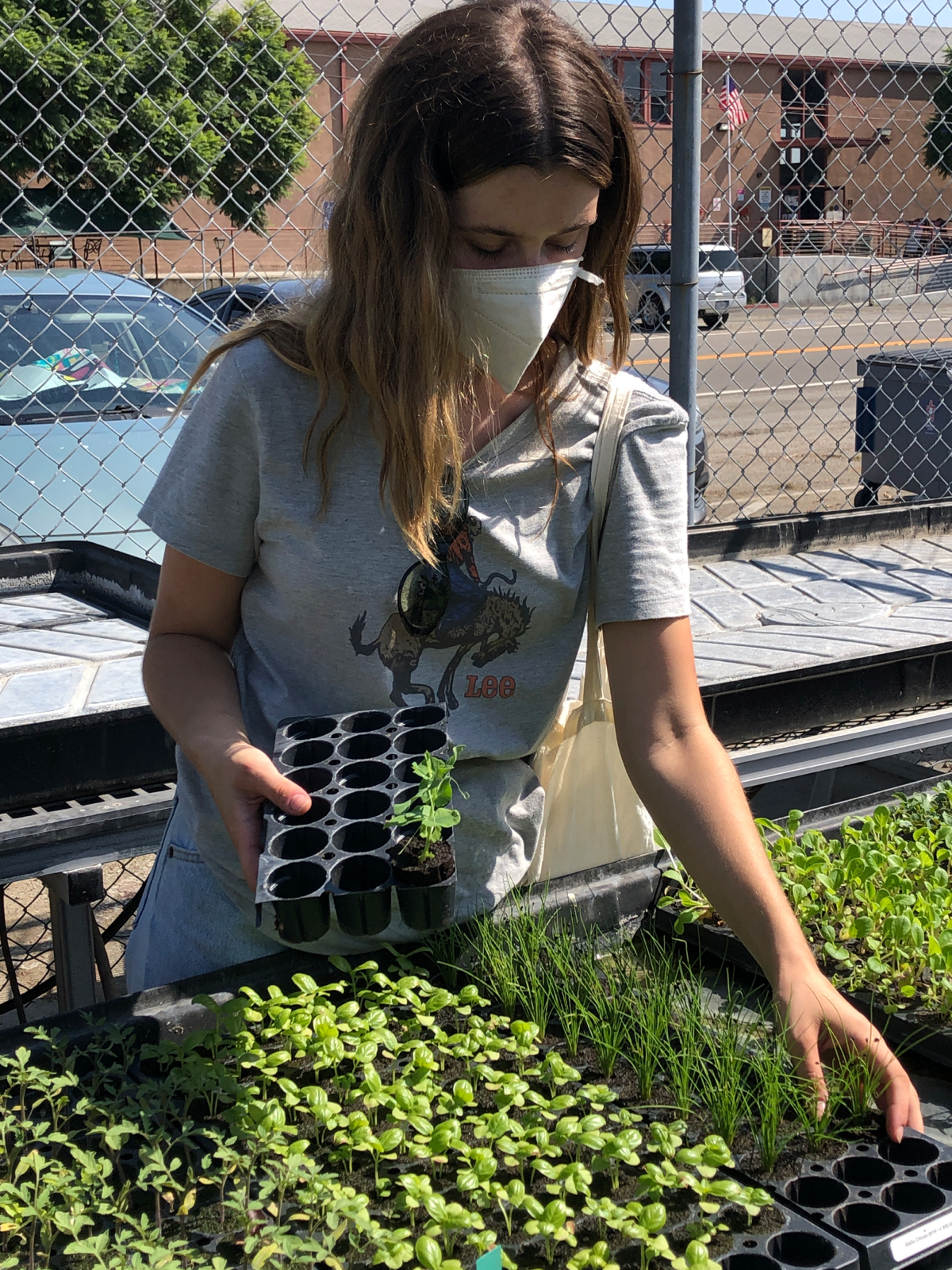
1 For US living wage methodologies, we’ve referenced: the MIT Living Wage Calculator to estimate the living wage needed to support “1 adult + 0 children”.
People SDG
5 Gender Equality, 8 Decent Work & Economic Growth, 10 Reduced Inequalities,
12 Responsible Consumption & Production, 17 Partnerships for the goals
GIVING BACK
We encourage our teams to take paid volunteer time off at least once a quarter. This year, our Community Action Committee created a volunteer database to make it even easier for Refs to get connected to causes that matter most to them. We organized company-wide events like cleanups and composting workshops and worked with food banks and homeless shelters to build care kits and pack lunches. In the month of December, Ref also matched employee donations to community organizations supporting those in need during the holidays.
PRODUCT
How and where we make our product matters. We focus on things like fiber standards and clean chemistry to ensure we lessen the environmental and social impacts of our stuff.
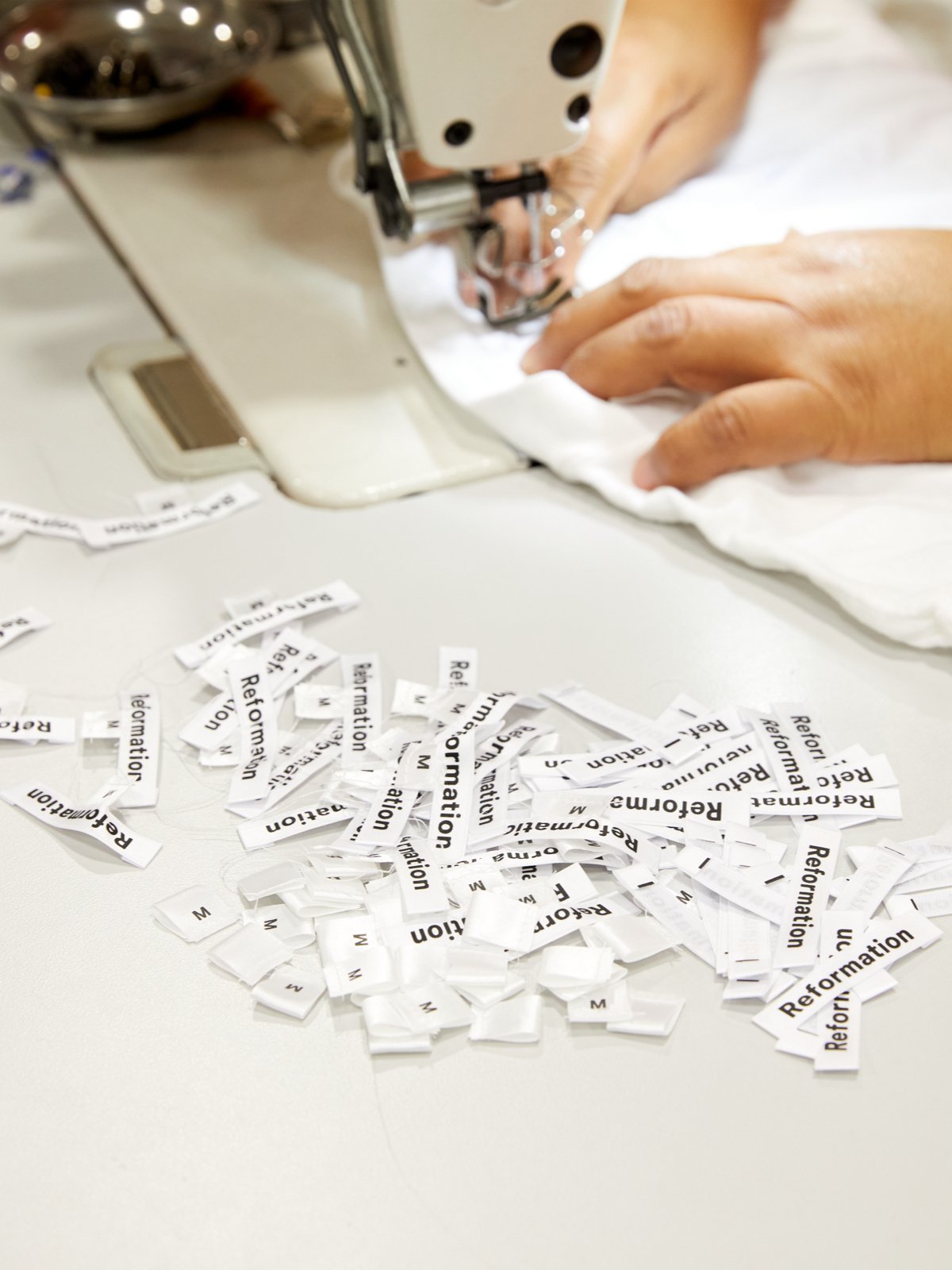
2021
HIGH
Invested in innovative materials
We want to leave the Earth better than we found it, so we launched two regenerative fiber collections in 2021. Regenerative fibers can help reverse climate change by absorbing more carbon than they release, therefore reducing carbon emissions in the atmosphere. Our FibreTrace™ denim collection featured Good Earth Cotton from the first climate positive farm in Australia and embedded traceability technology. We also worked with NATIVA™️ to source 100% traceable wool that's produced using regenerative practices.
For footwear, we launched shoes with Cereal Leather, our 100% vegan leather alternative, which contains just 25% virgin plastic–the lowest amount in any material out there.
LOW
We didn’t hit our clean chemistry goal
In 2021, our goal was to have 75% of our fabrics dyed and printed in facilities that hold third-party clean chemistry certifications like Oeko-Tex Standard 100 and bluesign®.2 We fell short by about 30%. Some of this was due to continued COVID-19 impacts on our sourcing last year, but regardless, we need to do better.
2022
FOCUS
Improve resource efficiency
This year showed us that partnering with our suppliers is key to reducing our environmental impact by improving energy, water, and chemical efficiency and pushing for zero hazardous chemical use in their facilities. To help support our goal, we joined as a bluesign® SYSTEM PARTNER and are committed to meeting the highest criteria in regards to resource efficiency, environmental impact, and worker and customer health and safety.
Tier 1
100%
Finished goods assemblers & subcontractors
Tier 2
100%
Dyers & printers; finishers, weavers, knitters
Tier 3
94%
Fibers, spinners, recycled material collector/processor
Tier 4
3%
Raw materials (Farm, Forest, Ranch)
We did it, but we aren’t stopping there. Next up, we’ll dig deeper into Tier 4 to influence sustainable practices at the very beginning of our product’s lifecycle.
Transparency is key to accountability, which is why we disclose 100% of Tier 1 finished goods manufacturers and subcontractors within our supply chain. We have promised to align with the Transparency Pledge and are participating in the Open Apparel Registry (OAR) to expand on the details that are made public so we can be more accountable for the working conditions in our partner factories. We’ve also signed onto the Call to Action by The Coalition to End Forced Labour in the Uyghur region. The Coalition’s Call to Action is endorsed by over 300 civil society organizations and labor groups who want to end human rights abuses against Uyghur people.
Fiber standards
The materials we use are a major driver of the total impact of our products. We have our own Ref Fiber Standards that are as holistic as possible, taking into consideration water input, energy input, land use, eco-toxicity, greenhouse gas emissions, human toxicity, availability, and price. We also look at garment care implications, like microfiber shedding. Our goal was to have 95% of fabric sourcing for apparel meet A/B for Ref’s Fiber Standards by 2022.
95% of our fabrics meet our A/B rating4

We’re passionate about working with our partner printers, dye houses, and tanneries to ensure responsible use of chemicals, water, and energy so that products are safe for workers, you, and the environment.
2 Certifications included in this total are Oeko-Tex Standard 100, bluesign®, Global Organic Textile Standard (GOTS), Global Recycled Standard (GRS), and Leather Working Group (LWG). Calculated for total fabric yardage that was used in 2021 excluding deadstock materials.
3 Traceability is calculated by total fabric yardage for apparel and by upper fabric volume for shoes 2021. This excludes all deadstock materials.
4 Fiber performance is calculated by total fiber volume usage YTD 2021. Leather and deadstock are measured by total material volume usage. Percentages have been rounded up.
5 Percent of clean chemical certifications for dyers, tanneries, and printers is calculated by total fabric yardage for apparel and upper fabric volume for shoes YTD 2021. This excludes all deadstock materials.
Product SDG
6 Clean Water & Sanitation, 12 Responsible Consumption & Production, 14 Life Below Water, 15 Life on Land
PLANET
We want to keep our planet safe for future generations, so we track and share the environmental impact of everything we do and innovate new ways to go easier on the Earth.

2021
HIGH
Climate Positive Roadmap
We made a commitment to be Climate Positive by 2025. We shared our roadmap of exactly what that means and how we plan to get there to hold ourselves accountable. We also published a guide to help other businesses that want to do the same.
LOW
Shifting baselines
One of our goals was to improve our reporting accuracy with more primary data and relevant emission factors. Good news, we were able to get this done in 2021! But that means we can’t really compare our current footprint to 2019 since how we calculated them was so different. And while we’d love to take the credit for some serious reductions, a lot of that came from better data and not necessarily more efficient practices. So change of plans: we’ll update 2021 as our new baseline. No sweat, we’ll keep our same Climate Positive ambition and timeline.
2022
FOCUS
Renewable energy within our supply chain
Climate Positive is a big goal, so we’re taking big steps to get there. This year, we’re partnering with industry experts to work with our suppliers to strengthen their environmental management systems, increase their resource efficiency, and transition their energy sources to renewables like solar and wind power. We’ll start by adding on-site solar to our own factory. We’ll be focusing on helping our suppliers set roadmaps to reduce their energy use and implement effective renewable sourcing strategies, like the purchase of Renewable Energy Credits (REC) and Energy Attribute Credits (EAC).
2021 Carbon Footprint
We calculate our total carbon footprint annually to keep us accountable and measure our progress towards our Climate Positive goals. Our footprint measures the total emissions associated with our onsite operations and our entire supply chain. Taking an inventory helps us better understand our impacts and where we can make the most meaningful change.
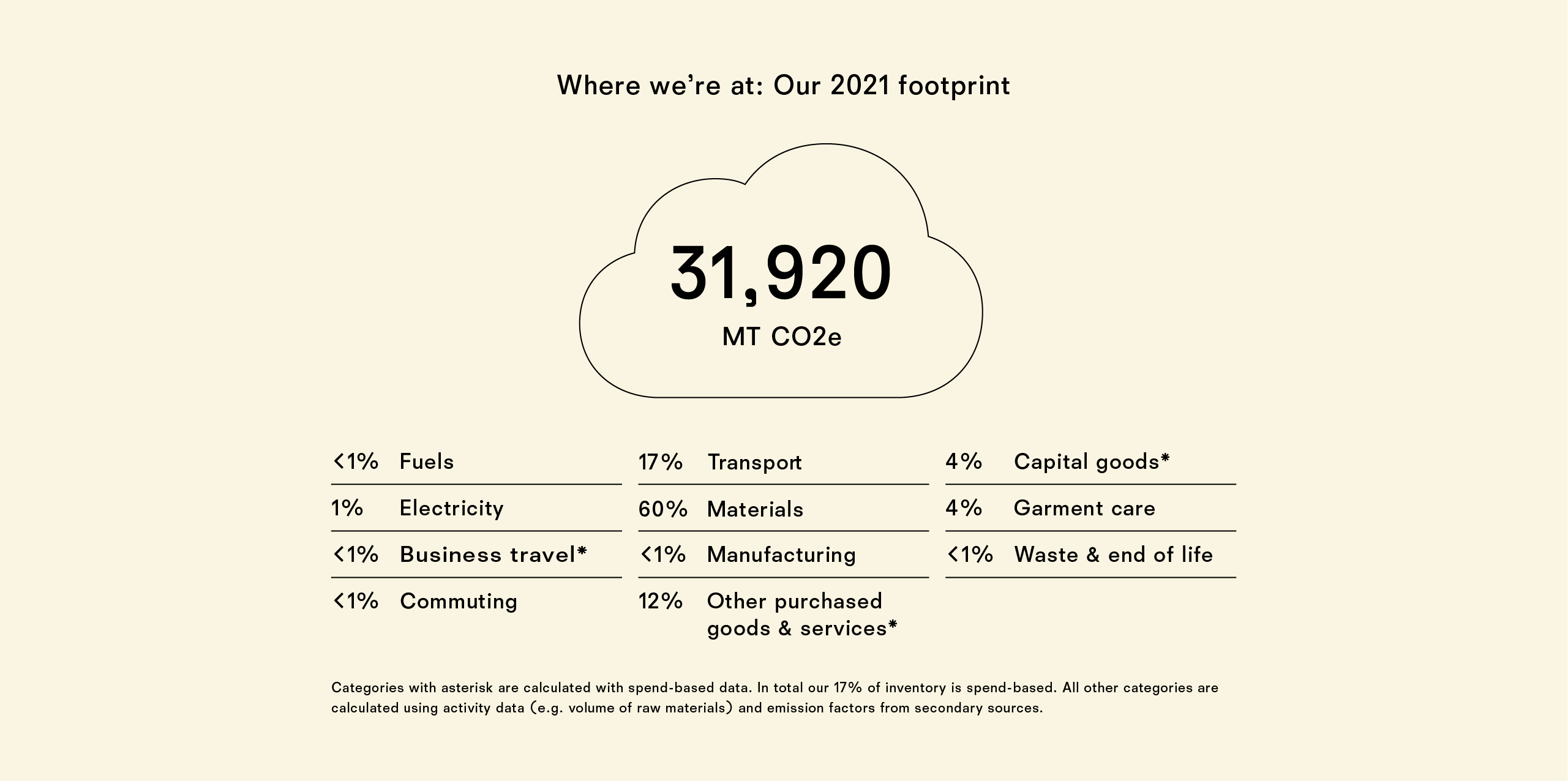
RefScale
RefScale tracks our environmental footprint by adding the pounds of carbon dioxide emitted, gallons of water used, and pounds of waste generated. Then we calculate how much Reformation saves compared to conventional clothes bought in the US. The whole equation follows the lifecycle of clothes—everything from growing textile fibers and making fabric, dyeing, transporting materials, manufacturing, packaging, shipping, garment care, and even recycling clothes when you’re done with them.6
We offset our product footprint 100% but always push for better materials, factories, and operations to keep our footprint as low as possible.
.jpg)
2021 Product Footprint
Carbon dioxide (Metric tons)
Ref footprint: 29,595
Conventional footprint: 64,631
Savings: 35,036
Water (M gallons)
Ref footprint: 3,013
Conventional footprint: 7,125
Savings: 4,112
Waste (Metric tons)
Ref footprint: 1,823
Conventional footprint: 1,899
Savings: 76
That’s like removing 7,620 cars off the road, reusing 6.23 olympic sized pools of water, and preventing 4.18 garbage trucks of waste.7
In 2021, we partnered with Native on CO2 reduction projects like supporting clean cookstoves in China, a clean energy project in India, and a reforestation project in Tanzania. Through our partnership with Bonneville Environmental Foundation (BEF), we’ve helped restore over 561 million gallons of water since 2015 by supporting projects across California and the Colorado River Basin. In 2021, our main project was a system conservation project with the Colorado River Indian Tribes (CRIT).
6 We publish our methodology on our website so you can really dig in and understand what we include in the calculations.
7 CO2 equivalency comes from the EPA Greenhouse Gas Equivalencies Calculator, Water from the Patagonia Alliance, and Waste from Frog Hauling.
Planet SDG
6 Clean Water & Sanitation, 7 Affordable & Clean Energy, 12 Responsible Consumption & Production, 13 Climate Action
PROGRESS
In order to push sustainability forward, we challenge our efforts and take risks to solve hard problems. We are committed to investing in the future, leading the way for a more sustainable fashion system, and will share our progress openly.
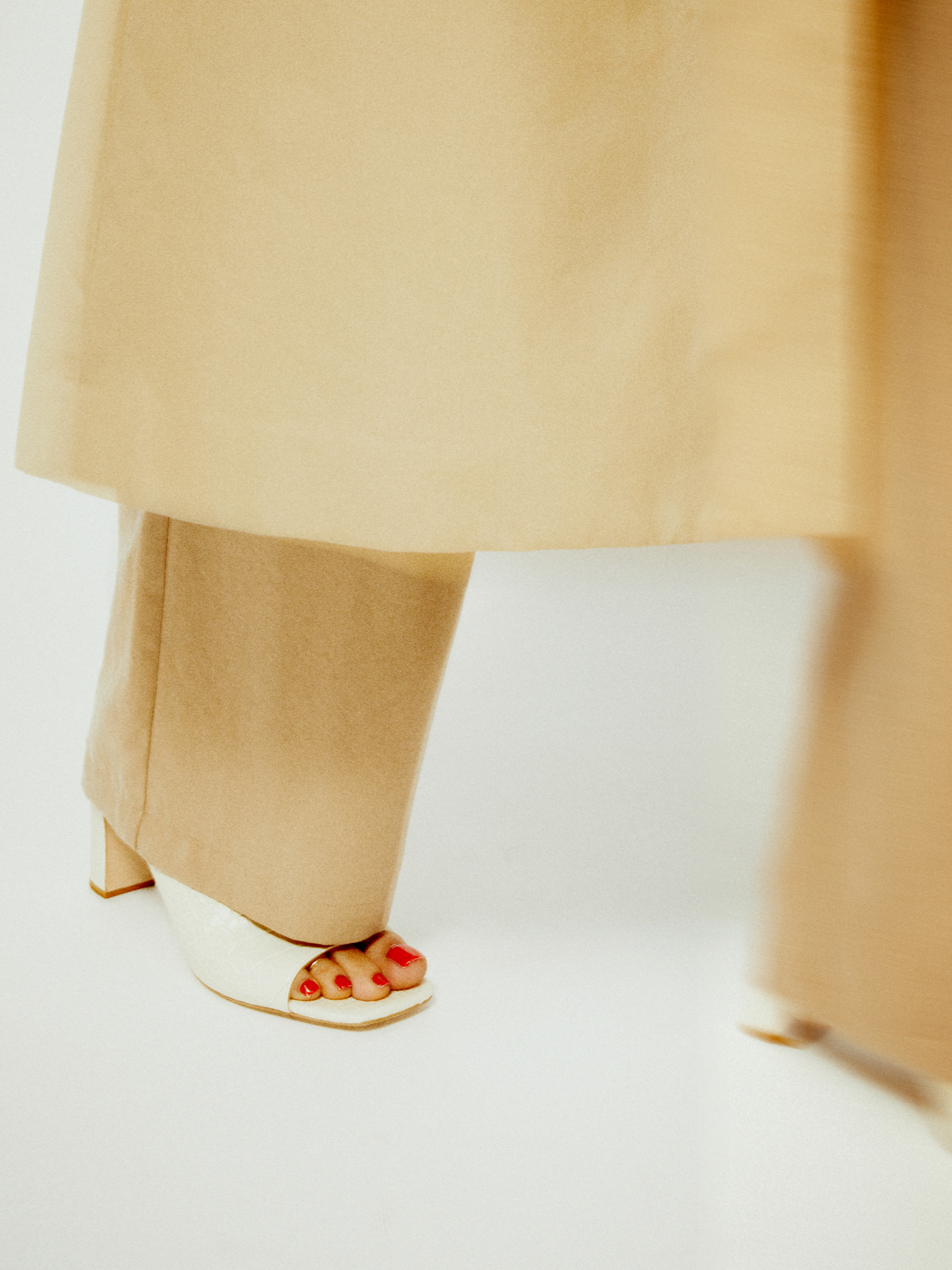
2021
HIGH
Launched RefRecycling for Ref Shoes
This year, we launched Ref Shoes, a more sustainable alternative to your average dress shoe. We focused on their whole lifecycle, starting at the beginning by knowing 100% of the farms our leather comes from, and going all the way to the end of our product’s life by making 100% of our shoes recyclable. In October, we rolled out the first phase of our RefRecycling program to enable shoe recycling at all US retail locations. For every pair recycled, you’ll get $25 in Ref Credit.
LOW
Didn’t reach our goal to reuse or recycle 500,000 garments
We got close, recycling or reusing almost 400,000 garments in 2021, a big portion of which comes from our resale program. We get that you have a ton of places to resell your Ref these days, and we’re just happy to see it staying in use out there. We’ll keep our partnership with thredUP going so we can make resale easy, but we’ll also look for other innovative ways to encourage recycling stuff that you can’t resell or keep wearing.
2022
FOCUS
Expand RefRecycling program
We’ll be expanding our recycling program to include more categories like active, denim, and sweaters. Our goal is to make new materials from the products that we take back, so we can eventually make new Ref out of old Ref. We want to take responsibility for the full lifecycle of our stuff and make it easy for you to recycle clothes so these materials can keep circulating in the fashion system.
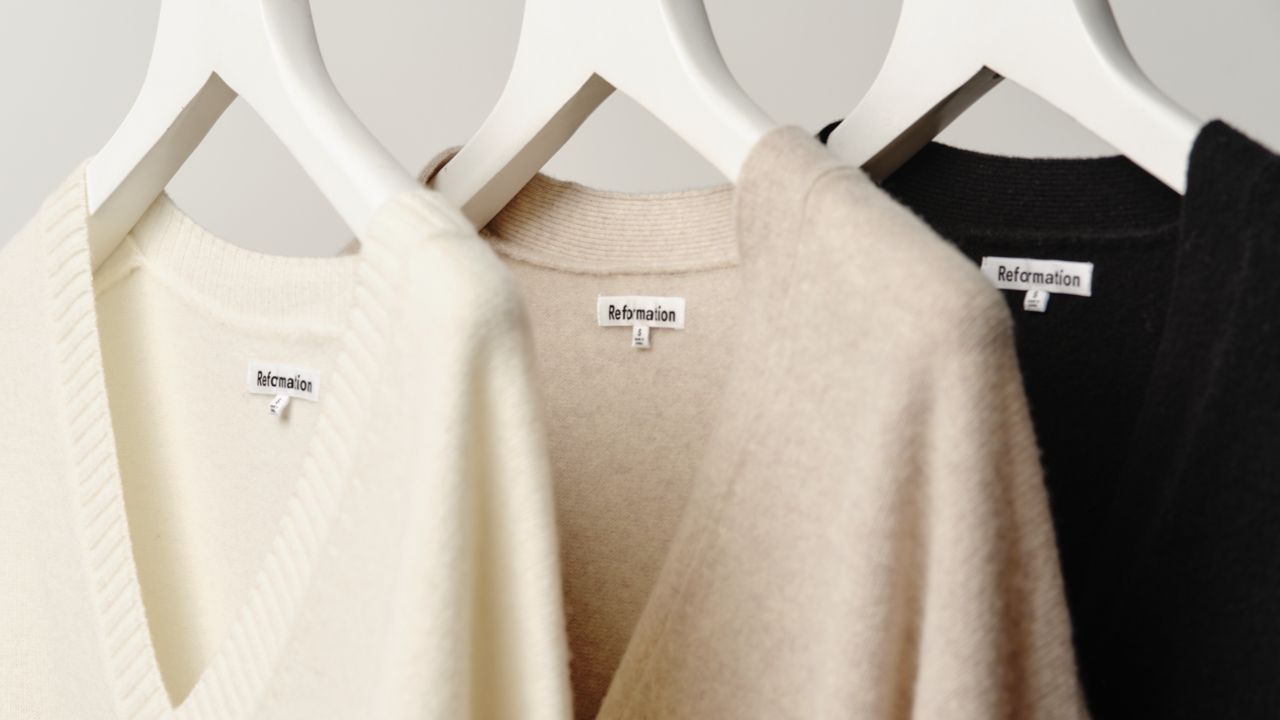
Never not circulating
There is actually enough clothing and textiles in existence today to meet our annual demand globally.
392,447 garments reused or recycled8
Equivalent to 3,103 metric tons of CO2, 20 million gallons of water, 244 metric tons of waste.
Learning together
It’s important to us that all Ref team members and our community understand why we do what we do, AKA, work on making fashion more sustainable. We’ve started by working with The Wardrobe Crisis to create a Sustainable Fashion 101 training course available to all employees. The course demystifies the science and the complexity of really important issues like climate change and social justice. This training aims to empower our team with the knowledge of what the issues are, what’s being done, and what we need to do together. This is open and available to everyone, so you can join too. In 2022, we’ll be expanding our hub of resources because it's our goal to be a destination for sustainability education and action.

United Nations Sustainable Development Goals
The fashion industry has a major impact on the global economy and the environment. That’s why we aligned our sustainability framework with the United Nations Sustainable Development Goals (SDGs) to make sure we’re tackling the most important issues like climate change and economic inequality.

1 This includes Ref Vintage, Rent the-Runway, thredUP, Looptworks, and donations.
Progress SDG
12 Responsible Consumption & Production, 15 Life on Land
Okay, that’s all for now.
Read our Q3 updates.
